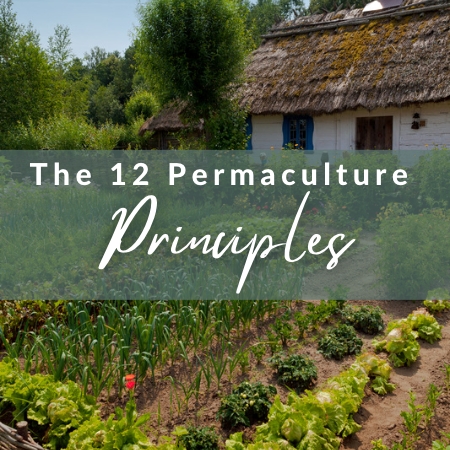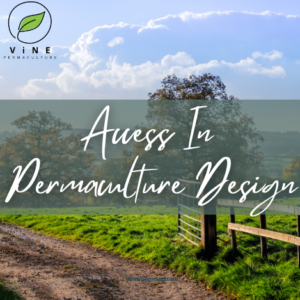The 12 Permaculture Principles are design elements that work together and are guided by the 3 permaculture ethics. (Click here for the blog on permaculture ethics.)
Each principle outlines aspects that are included when creating a good design. Using design principles in property planning creates resiliency and a sustainable self-reliant site.

Observe & Interact

By observing our surroundings we get a better understanding of the dynamics at play. From season to season we will see changes in rainfall, sun, and yield. We will observe wind direction and the impact it has on the property. When we do this, it helps with finding solutions to property challenges. Observe and interact also helps with each of the following principles…
Catch & Store Energy
This is a form of using renewable resources but it is also about planning the resources needed. Water is an excellent example of this principle. Water harvested from the roof becomes stored in a tank. Water is also stored in the soil by using keyline, swale, or dam systems. By catching resources at their highest yield, they are stored and used when they’re needed later.
Obtain a Yield
A yield may be fruit, veggies, solar energy, or water capture. This is about making the most use of each of the elements on the property. David Holmgren uses the saying “you can’t work on an empty stomach” as an example of this principle. Without the yield, you or the property may be non-operational.
Apply Self-Regulation & Accept Feedback

This principle sounds a little cryptic but it is quite basic. A lot of it is about cause and effect. When we have designed without consideration of the other principles, things may suffer. This will not be evident at first but will be the result over time. It is important to accept feedback and tweak the design early, to prevent future issues.
Use & Value renewable resources & Services
When we make the most of a property’s abundance we rely less on outside input. Our high consumerism, disposable society, is dependent on ‘grocery stores’ and ‘power grids’. But what if we make changes to our behavior, and catch and store this ourselves? We could take care of the earth and be more in control of our health, resources, and food chain. Reduce and reuse, isn’t that the motto these days?
Produce no Waste
Making use of all resources on the property, even those seen as ‘rubbish’ or ‘gross’, is smart! An example you may be most familiar with is the concept of composting! By taking kitchen scraps, animal bedding, and manure, you can build soil. This reduces external inputs while increasing soil fertility (resulting in higher crop yields). Soil health is integral because it is the foundation of a property! So, instead of throwing something out think about how it can still be useful.
Design from Patterns to Details

When we observe something we start to understand its connection to things around it. It is then we may start to notice patterns. The rosette pattern in cabbage is like rose flower petals. And the herb spiral is like an eddy of water rushing past a rock. These patterns guide a good designer, helping them to plan the best design.
Integrate Rather than Segregate

Once again, think about the principle Observe & Interact. The act of observing the relationship between two things becomes very important. It may be on a large scale, such as the relationship between the mountain and the weather. Or on a small scale, such as the relationship between fungi and roots. Living systems have many parts and when they’re working together it creates balance. Integrating rather than segregating is harmonious.
Use Small & Slow Solutions
Small and slow is much easier to maintain, especially over time. A good example is a client I had last year who had never gardened before. She wanted an instant food forest and annual beds installed. We had recommended a phased approach. The client worried about food shortages and installed everything at once anyway. By the end of the growing season, our client became overwhelmed. There was much to learn. Much to maintain. A yield they didn’t know how to handle, preserve, or where to donate. And all at once, it was too much. Small, slow solutions are key.
Use & Value Diversity

Diversity creates a resilient system and reduces vulnerabilities. When there is too much of something, a balanced system, and good design can correct it. Increasing the diversity of plants and soil life in a system increases the health of the system. This builds health resiliency against pests and disease. An example of resiliency due to diversity… If the weather takes out a tree here or there, another will grow in its place. We value nature’s design and a good designer will mimic it in their designs.
Use edges and Value the Marginal
This is about making the most of every last inch of space. The edge area of a path is a great opportunity to grow food or plants you will regularly walk by. This makes it easy to harvest and uses less of your energy to do so. When planting on curved rows, instead of straight ones, you increase the edge! This means an increase in crop yields. That may be pretty important when it’s been a bad season, or you have a small space. Common permaculture methods used are keyhole gardens, vertical grow systems and herb spirals.
Creatively use & Respond to Change

While observing the systems we are a part of we begin to see the patterns, and the changes and are better able to respond. For example; during the monsoon rains there is a gully where the water is rushing and eroding the banks. This is an opportunity to increase water capture in the soil. We respond deliberately. We harvest the water while reducing erosion. This increases habitat opportunities and diversity in the landscape. When we observe, we can intervene!
A good designer will use these principles in every part of their design process. It’s all about doing things smarter, not harder.



